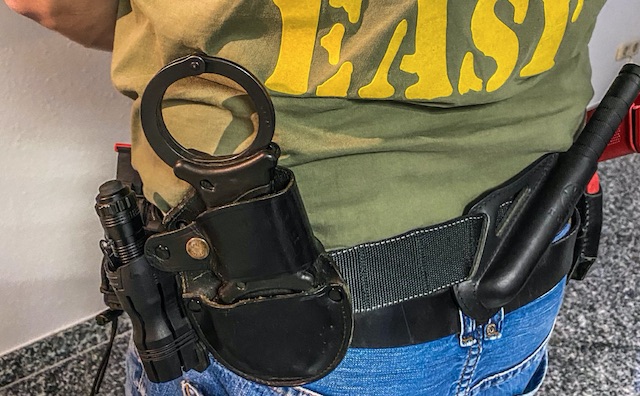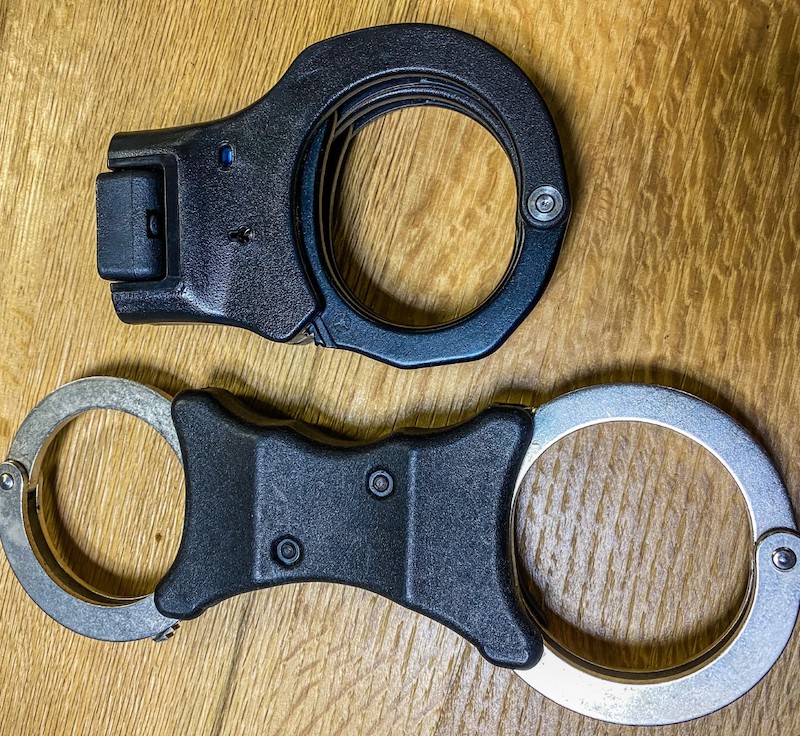Hol Dir den wöchentlichen SPARTANAT-Newsletter.
Dein Bonus: das gratis E-Book von SPARTANAT.

GUIDE: How to Speedcuffs
SICHERHEITSAGENTUR GEILLINGER hat euch letztmals erklärt, wie man den Einsatzstock sinnvoll tragen kann. Jetzt geht es um ein anderes, wichtiges Utensiel: Speedcuffs oder auch Rigid Cuffs genannt sind Handschließen ohne Gelenk oder Kette, die Handgelenkringe sind dabei durch ein starres Mittelteil verbunden.
Zuerst war diese Art von Handschließen nur auf der „Insel“ in England flächendeckend bei den „Bobbys“ verbreitet, sie finden aber bei immer mehr Anwendern Beliebtheit, wie z.B. bei der Deutschen Justiz.
Leider kaufen die Beschaffer der Behörden aber immer noch in großen Stückzahlen die klassischen Produkte mit Kette ein, dabei haben gerade diese Modelle nur wenige Vorteile gegenüber ihren „steifen“ Arbeitskollegen.
Die Modularität mit vielen bestehenden Tragevorrichtungen könnte z.B. als Vorteil gegenüber den Speedcuffs gelten gelassen werden, wobei der Holstermarkt für die speerigen Kollegen immer größer wird.
Die klassischen Handschliessen lassen sich auch weniger auffällig führen wie die starren Schließen, aber auch dieses Argument kann entkräftet werden.

Nein nicht nur bei den Autos gibt’s die Hybriden, nein das gibt es auch bei starren Handschliessen, quasi die eierlegende Wollmilchsau unter den Handschliessen. Das sind sogenannte Rigid Cuffs, die sich zusammengeklappt wie eine herrkömliche Handschließe führen lassen, ausseinandergeklappt sich aber selbstständig verriegeln, damit zur „Rigid“ werden, und mit dem Handschließenschlüssel sich wieder nach Gebrauch zusammen klappen lassen.
Also auch die Verwendung von Klassikern mit bereits bestehenden Tragevorrichtungen als Kaufargument kann entkräftet werden.
Tragevorrichtungen, Pouches oder auch Holster genannt haben am Dienstgürtel oder an der Weste ihren wohlüberlegten Platz.
Wir sind ja ausreichend auf die Führmöglichkeiten der Teleskop-Einsatzstöcke in einem unserer letzten Beiträge eingegangen, wir können Euch beruhigen, so ausführlich wird es diesmal nicht, weil das tragen von Handschliessen ein anderes Schema verfolgt.
Wie man Speedcuffs richtig trägt
Es gibt zwei Grundsätze der man bei der Montage von den Tragevorrichtungen für Handschließen Beachtung schenken muss. Das eine ist die Positionierung dort, wo sie meine „First Line“ Einsatzmittel beim zum Einsatz bringen nicht behindert. Als „First Line“ Einsatzmittel sind jene Einsatzmittel zu verstehen, die in der Regel Vorrang vor Handschliessen bei der Anwendung haben, wie z.B. die Primärwaffe (i.d.R. Pistole/Revolver), Teleskop-Einsatzstock, OC-Reizgas, Taschenlampe. Ob man die Handschliessen dann auf der Seite der schwachen oder starken Hand positioniert bleibt dem Geschmack des Anwenders überlassen. Es gibt aber Anwender, die denken sie sind schlau, wenn sie die Handschliessen auf der 6 Uhr Position, also auf der Wirbelsäule, positionieren, damit sie diese sowohl mit der linken wie mit der rechten erreichen können. Hier wären wir dann beim zweiten Grundsatz wo man die Handschliessen positioniert, nämlich dort nicht(!), ihr habt nur eine Wirbelsäule und die ist bei einem Sturz auf den Rücken weicher wie ein paar hundert Gramm Stahl.

Wie gesagt, hat die Handschliesse oft das Nachsehen in der Anwendungsreihenfolge, aber warum heißen die Dinger worin es hier geht „Speedcuffs“ und nicht „Slowcuffs“, wenn sie erst zum Einsatz kommen, wenn die Situationen beherrscht werden?
Nun, es kann Situationen geben, wo Einsatzkräfte angegriffen werden, es aber nicht verhältnismässig wäre den Teleskop-Einsatzstock, das OC-REIZGAS oder gar die Schusswaffe einzusetzen. Z.B. wird der Operator an der Kleidung festgehalten, oder gewürgt. Der Angegriffene kann sich dieser Haltegriffe leicht entledigen, indem er eines der Handgelenke des Angreifers mit der „Speedcuff“ schließt, und wie der Name des Einsatzmittels lautet sollte auch das Schließen mit einer gewissen Dynamik geschehen. Solche Techniken gehen mit starren Handschliessen sehr gut, vielleicht schafft der Verteidiger es auch noch in so einer Situation eine Schliesse mit Kette aufzuschliessen, aber was dann?
Speedcuffs in der Anwendung
Er wird den Griff dann nicht lösen können, weil er keine Hebelkraft mit der Handschliesse auf das Handgelenk erzeugen kann. Der „Speedcuff“ Nutzer im Gegenteil hat die Hebelgesetze dann nur auf seiner Seite, und kaum ein Mensch auf dieser Welt kann diesen Hebelkräften entgegen wirken, zumal mit der Hebelkraft auch empfindliche Schmerzpunkte getroffen werden.
Ist der Griff gelöst, ist es ein Einfaches den Angreifer mit der Handschliesse um sein Handgelenk zu Boden zu bringen und zu kontrollieren.
Gleiches gilt bei einem vemeintlich kontrollierten Schließvorgang eines Festgenommenen, der dabei plötzlich in einem Widerstand mündet. Ist eine Schliesse der „Speedcuf“ aufgeschlossen, ist mit dem Widerstand schnell vorbei, weil auch dieser Deliquent so leicht zu kontrollieren sein wird.
Ein weiterer großer Vorteil der starren Handschliessen ist beim Gefangenentransport ersichtlich. Oft hält die Einsatzkraft den Gefangenen in der Mitte der Handschliesse, bei Schliessen mit Kette schafft es der eine oder andere Gefangene die Finger der Einsatzkraft einzuquetschen, was sehr schmerzhaft ist. Wird der Gefangene vorne geschlossen, werden die Hände wechselseitig geschlossen, ein Würgen oder ein Zuschlagen einer anderen Person durch den Gefangenen wird so nahezu unmöglich.
Wir haben uns gut überlegt kein Bildmaterial zur Verfügung zu stellen, was die die Techniken in der Anwendung angeht. Wir wollen ja wissen, wem wir dieses Know How vermitteln und nicht dem Gegenüber von Einsatzkräften einen Vorteil verschaffen.
GUIDE: Führmöglichkeiten der Teleskop-Einsatzstöcke
SICHERHEITSAGENTUR GEILLINGER im Internet
SPARTANAT ist das Online-Magazin für Military News, Tactical Life, Gear & Reviews.
Schickt uns eure News: [email protected]
Werbung
Hol Dir den wöchentlichen SPARTANAT-Newsletter.
Dein Bonus: das gratis E-Book von SPARTANAT.


